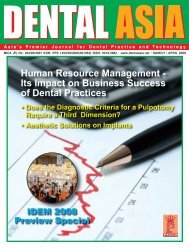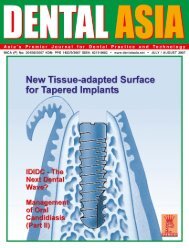Download - Dental Asia
Download - Dental Asia
Download - Dental Asia
You also want an ePaper? Increase the reach of your titles
YUMPU automatically turns print PDFs into web optimized ePapers that Google loves.
USERREPORT<br />
by Drs Birgit Grubeanu-Block & Daniel Grubeanu<br />
Long-term Esthetic<br />
Stability Through<br />
Structure Retention<br />
Patients interested in implant therapy are particularly interested in an<br />
esthetic, friendly and simply brilliant smile. Advanced dental technology is<br />
being used to make the visible white components of the dental prosthesis<br />
more demanding esthetically. However, a really natural appearance can<br />
only be achieved in combination with an emergence profile that is<br />
indistinguishable from the neighboring teeth. An essential condition for acceptable<br />
peri-implant soft-tissue esthetics is therefore the retention of the structures around<br />
the implant. But exactly how can bone and soft tissue remain stable over the long<br />
term? And above all what factors must be taken into account for this?<br />
Figure 1 Pre-operative situation<br />
Biological Width, Dentogingival Complex<br />
of Teeth and Implants<br />
The term “biological width” describes the dimension of certain periodontal and<br />
peri-implant soft-tissue structures, the gingival sulcus, marginal epithelium and<br />
supracrestal connective tissue. Because marginal epithelium and supracrestal<br />
connective tissue can adhere to teeth and implants, this is referred to as epithelial<br />
and connective-tissue attachment. The basic principle of the biological width is<br />
that bone projecting into the oral cavity is always covered by periosteum,<br />
connective tissue and epithelium (Tarnow et al. 2000). The epithelial and<br />
connective-tissue attachment in this case has a specific thickness (dimension).<br />
Animal studies have demonstrated that the thickness of the peri-implant soft<br />
tissues remains relatively constant at 3 mm (Buser et al. 1992; Berglundh et al.<br />
1996; Cochan et al. 1997; Hermann et al. 2000; Todescan et al. 2002).<br />
Peri-implant Bone Resorption<br />
Possible causes for peri-implant bone resorption are among the following:<br />
1. Surgical trauma during placement of implant and abutment (Brånemark et al.<br />
1969; Adell et al. 1986; Cochran et al. 1997)<br />
Figure 2 Mucosa conditions<br />
2. Positioning of the implant relative to the alveolar ridge with supracrestal,<br />
Figure 3 View of the alveolar arch of maxilla Figure 4 Subcrestal placement of the Ankylos implant Figure 5 Facial bone deficit<br />
<strong>Dental</strong> <strong>Asia</strong> • May / June 2008<br />
43





